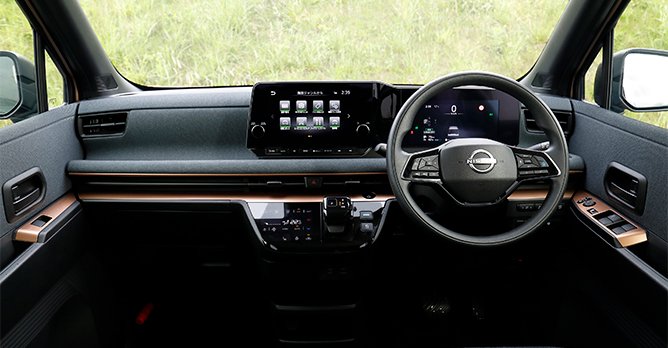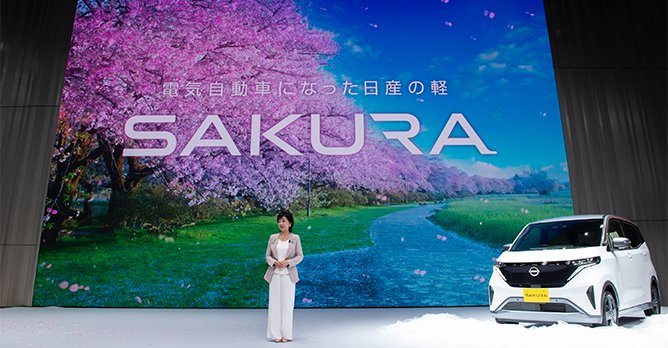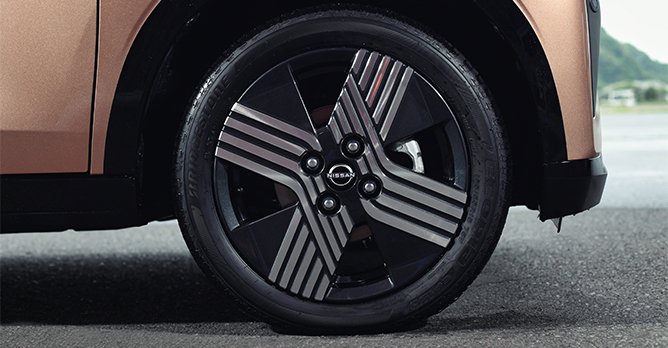The all new Nissan Sakura is a fully electric kei car with up to 180km of range
24 May 2022|2,640 views
Nissan has unveiled its latest EV - the all-electric Sakura, which also marks the Japanese manufacturer's first all-electric kei car offering.
Taking inspiration from Japan's iconic cherry blossoms for its name, the car is being positioned by Nissan as a mass-market EV, which it hopes will serve as a "gamechanger for the Japanese market".
Up front, the car gets a bold grille that brings it in line with Nissan's current line-up of vehicles. As an apparent first on a mini-vehicle, projector-type triple beams in its headlights will aid in visibility and safety at night.
Elsewhere, the car's design continues to reference Japanese culture, with aluminium wheels that are apparently inspired by Japanese mizuhiki decorative knots, commonly seen on gift envelopes and packages. Nissan says fifteen body colours will be available for Sakura-buyers, including four two-tone options.
The car's interior is also promising to be both a modern and, of course, utilitarian space (as a kei car should be) that will hold beverages, smartphones and wallets all at once - all staples for modern-day Japan. A 7-inch Advanced Driver Assist Display greets the driver right behind the steering wheel, while the centre of the dash houses another 9-inch display that can provide both navigation and Apple CarPlay connectivity.

 In-built navigation and Apple CarPlay can be used on certain trim levels via the car's 9.0-inch infotainment display Driving assistance systems, too, will be available on certain trim levels, as will Nissan's ProPilot Park system that can automatically slot the car into a parking lot (although we're not sure why anyone would need it with something so small).
In-built navigation and Apple CarPlay can be used on certain trim levels via the car's 9.0-inch infotainment display Driving assistance systems, too, will be available on certain trim levels, as will Nissan's ProPilot Park system that can automatically slot the car into a parking lot (although we're not sure why anyone would need it with something so small).
As expected, the Sakura will not be the last word in raw power, although it still promises to be properly zippy thanks to its electric drivetrain. A 20kW lithium-ion battery pack - apparently similar in design to the one used in the Leaf - will produce 47kW (63bhp) and 190Nm of torque, and will help the Sakura achieve a top speed of 130km/h. That battery also gives the Sakura a Japanese-rated WLTP range of 180km - not terribly much, albeit fully coherent with its city-centric disposition.

 Nissan is hoping that the Sakura, as its first fully electric mini-vehicle, will be a gamechanger for the Japanese market Like Nissan's other electrified models, the Sakura will also come with the firm's e-Pedal Step. This system essentially allows for one-pedal driving; the vehicle's speed can be modulated entirely with the accelerator pedal, since lifting off it charges the battery through regenerative braking.
Nissan is hoping that the Sakura, as its first fully electric mini-vehicle, will be a gamechanger for the Japanese market Like Nissan's other electrified models, the Sakura will also come with the firm's e-Pedal Step. This system essentially allows for one-pedal driving; the vehicle's speed can be modulated entirely with the accelerator pedal, since lifting off it charges the battery through regenerative braking.
Speaking of charging, the Sakura's battery architecture will also support fast charging from 10% to 80% within 40 minutes (Nissan's press release doesn't state the power rating). A standard charge via an alternating current outlet, on the other hand, will take about eight hours.
Interestingly too, the direct-to-consumer sales model that we recently covered will be applied to the Sakura when it goes on sale this summer in Japan. Nissan states that it will "offer online purchasing options such as video chats and a dedicated website", allowing customers to tap on "full online orders from the comfort of their home". Retail prices of the Sakura are set to start at 1,780,000 yen (about S$19,200).
Taking inspiration from Japan's iconic cherry blossoms for its name, the car is being positioned by Nissan as a mass-market EV, which it hopes will serve as a "gamechanger for the Japanese market".
Up front, the car gets a bold grille that brings it in line with Nissan's current line-up of vehicles. As an apparent first on a mini-vehicle, projector-type triple beams in its headlights will aid in visibility and safety at night.
Elsewhere, the car's design continues to reference Japanese culture, with aluminium wheels that are apparently inspired by Japanese mizuhiki decorative knots, commonly seen on gift envelopes and packages. Nissan says fifteen body colours will be available for Sakura-buyers, including four two-tone options.
The car's interior is also promising to be both a modern and, of course, utilitarian space (as a kei car should be) that will hold beverages, smartphones and wallets all at once - all staples for modern-day Japan. A 7-inch Advanced Driver Assist Display greets the driver right behind the steering wheel, while the centre of the dash houses another 9-inch display that can provide both navigation and Apple CarPlay connectivity.

As expected, the Sakura will not be the last word in raw power, although it still promises to be properly zippy thanks to its electric drivetrain. A 20kW lithium-ion battery pack - apparently similar in design to the one used in the Leaf - will produce 47kW (63bhp) and 190Nm of torque, and will help the Sakura achieve a top speed of 130km/h. That battery also gives the Sakura a Japanese-rated WLTP range of 180km - not terribly much, albeit fully coherent with its city-centric disposition.

Speaking of charging, the Sakura's battery architecture will also support fast charging from 10% to 80% within 40 minutes (Nissan's press release doesn't state the power rating). A standard charge via an alternating current outlet, on the other hand, will take about eight hours.
Interestingly too, the direct-to-consumer sales model that we recently covered will be applied to the Sakura when it goes on sale this summer in Japan. Nissan states that it will "offer online purchasing options such as video chats and a dedicated website", allowing customers to tap on "full online orders from the comfort of their home". Retail prices of the Sakura are set to start at 1,780,000 yen (about S$19,200).
Nissan has unveiled its latest EV - the all-electric Sakura, which also marks the Japanese manufacturer's first all-electric kei car offering.
Taking inspiration from Japan's iconic cherry blossoms for its name, the car is being positioned by Nissan as a mass-market EV, which it hopes will serve as a "gamechanger for the Japanese market".
Up front, the car gets a bold grille that brings it in line with Nissan's current line-up of vehicles. As an apparent first on a mini-vehicle, projector-type triple beams in its headlights will aid in visibility and safety at night.
Elsewhere, the car's design continues to reference Japanese culture, with aluminium wheels that are apparently inspired by Japanese mizuhiki decorative knots, commonly seen on gift envelopes and packages. Nissan says fifteen body colours will be available for Sakura-buyers, including four two-tone options.
The car's interior is also promising to be both a modern and, of course, utilitarian space (as a kei car should be) that will hold beverages, smartphones and wallets all at once - all staples for modern-day Japan. A 7-inch Advanced Driver Assist Display greets the driver right behind the steering wheel, while the centre of the dash houses another 9-inch display that can provide both navigation and Apple CarPlay connectivity.

 In-built navigation and Apple CarPlay can be used on certain trim levels via the car's 9.0-inch infotainment display Driving assistance systems, too, will be available on certain trim levels, as will Nissan's ProPilot Park system that can automatically slot the car into a parking lot (although we're not sure why anyone would need it with something so small).
In-built navigation and Apple CarPlay can be used on certain trim levels via the car's 9.0-inch infotainment display Driving assistance systems, too, will be available on certain trim levels, as will Nissan's ProPilot Park system that can automatically slot the car into a parking lot (although we're not sure why anyone would need it with something so small).
As expected, the Sakura will not be the last word in raw power, although it still promises to be properly zippy thanks to its electric drivetrain. A 20kW lithium-ion battery pack - apparently similar in design to the one used in the Leaf - will produce 47kW (63bhp) and 190Nm of torque, and will help the Sakura achieve a top speed of 130km/h. That battery also gives the Sakura a Japanese-rated WLTP range of 180km - not terribly much, albeit fully coherent with its city-centric disposition.

 Nissan is hoping that the Sakura, as its first fully electric mini-vehicle, will be a gamechanger for the Japanese market Like Nissan's other electrified models, the Sakura will also come with the firm's e-Pedal Step. This system essentially allows for one-pedal driving; the vehicle's speed can be modulated entirely with the accelerator pedal, since lifting off it charges the battery through regenerative braking.
Nissan is hoping that the Sakura, as its first fully electric mini-vehicle, will be a gamechanger for the Japanese market Like Nissan's other electrified models, the Sakura will also come with the firm's e-Pedal Step. This system essentially allows for one-pedal driving; the vehicle's speed can be modulated entirely with the accelerator pedal, since lifting off it charges the battery through regenerative braking.
Speaking of charging, the Sakura's battery architecture will also support fast charging from 10% to 80% within 40 minutes (Nissan's press release doesn't state the power rating). A standard charge via an alternating current outlet, on the other hand, will take about eight hours.
Interestingly too, the direct-to-consumer sales model that we recently covered will be applied to the Sakura when it goes on sale this summer in Japan. Nissan states that it will "offer online purchasing options such as video chats and a dedicated website", allowing customers to tap on "full online orders from the comfort of their home". Retail prices of the Sakura are set to start at 1,780,000 yen (about S$19,200).
Taking inspiration from Japan's iconic cherry blossoms for its name, the car is being positioned by Nissan as a mass-market EV, which it hopes will serve as a "gamechanger for the Japanese market".
Up front, the car gets a bold grille that brings it in line with Nissan's current line-up of vehicles. As an apparent first on a mini-vehicle, projector-type triple beams in its headlights will aid in visibility and safety at night.
Elsewhere, the car's design continues to reference Japanese culture, with aluminium wheels that are apparently inspired by Japanese mizuhiki decorative knots, commonly seen on gift envelopes and packages. Nissan says fifteen body colours will be available for Sakura-buyers, including four two-tone options.
The car's interior is also promising to be both a modern and, of course, utilitarian space (as a kei car should be) that will hold beverages, smartphones and wallets all at once - all staples for modern-day Japan. A 7-inch Advanced Driver Assist Display greets the driver right behind the steering wheel, while the centre of the dash houses another 9-inch display that can provide both navigation and Apple CarPlay connectivity.

As expected, the Sakura will not be the last word in raw power, although it still promises to be properly zippy thanks to its electric drivetrain. A 20kW lithium-ion battery pack - apparently similar in design to the one used in the Leaf - will produce 47kW (63bhp) and 190Nm of torque, and will help the Sakura achieve a top speed of 130km/h. That battery also gives the Sakura a Japanese-rated WLTP range of 180km - not terribly much, albeit fully coherent with its city-centric disposition.

Speaking of charging, the Sakura's battery architecture will also support fast charging from 10% to 80% within 40 minutes (Nissan's press release doesn't state the power rating). A standard charge via an alternating current outlet, on the other hand, will take about eight hours.
Interestingly too, the direct-to-consumer sales model that we recently covered will be applied to the Sakura when it goes on sale this summer in Japan. Nissan states that it will "offer online purchasing options such as video chats and a dedicated website", allowing customers to tap on "full online orders from the comfort of their home". Retail prices of the Sakura are set to start at 1,780,000 yen (about S$19,200).
Latest COE Prices
June 2025 | 2nd BIDDING
NEXT TENDER: 09 Jul 2025
CAT A$98,124
CAT B$116,670
CAT C$65,000
CAT E$116,889
View Full Results Thank You For Your Subscription.





























